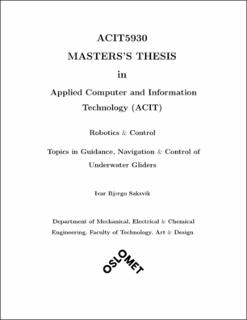| dc.description.abstract | This thesis is concerned with the topics of modeling, guidance, navigation, and control of underwater gliders, related to a special class of autonomous underwater vehicles (AUVs). Gliders main source of locomotion is a buoyancy engine which allows the vehicle to perform repeating upward and downward glides in the water column. To control the attitude and heading, internal moving mass actuators are exploited. A mathematical model of the fixed-wing underwater glider is derived, including rigid-body dynamics, hydrodynamics, and hydrostatic forces. The glider model is implemented in a numerical framework to simulate generic glider motions and to validate guidance, navigation and control systems.
PID feedback control laws are proposed for heading and pitch control of the simulated buoyancy propelled glider. The control laws are further cascaded with a guidance and navigation system in a feedback loop. Navigation is considered a notorious challenge in underwater gliders due to the limitations of navigational instruments. In practice, inertial measurement units (IMUs) and depth sensors are commonly used sensors for dead-reckoning (DR) navigation. Considering a limited sensor suite, we investigate how deep learning (DL) models e.g. artificial neural networks can be exploited to aid DR navigation. The proposed networks predict the planar velocities of the vehicle, which are further used to approximate the planar displacement through time integration.
The second part of the thesis investigates path-following/guidance laws for underactuated underwater gliders. Line-of-sight (LOS) guidance laws are presented for the straight-line path-following control problem. Various simulations are carried out to evaluate the performance when affected by different ocean current disturbances using the numerical glider model.
In addition to the latter topics, we propose a target tracking scheme of underwater gliders using unmanned surface vehicles (USVs) for the purpose of target localization. A target tracking guidance law is implemented in a topside USV to pursue generic motions of the submerged glider from the surface. The target-tracking scheme was validated in a simulation environment of the two vehicles. | en_US |
